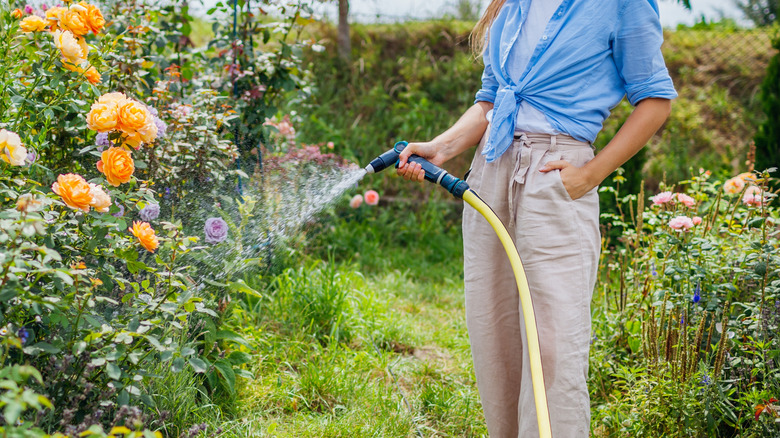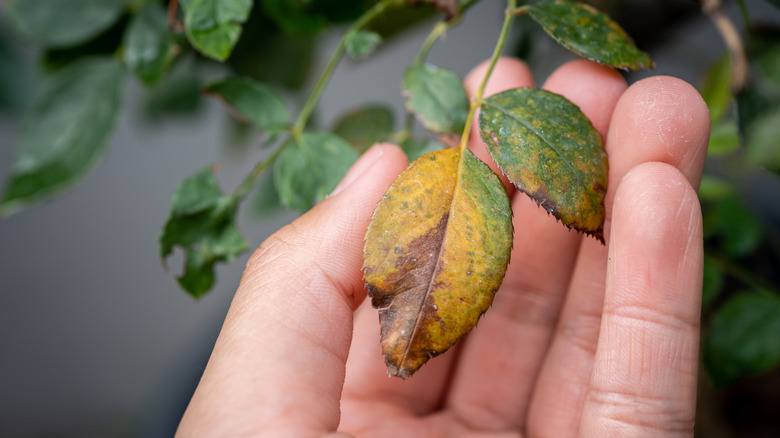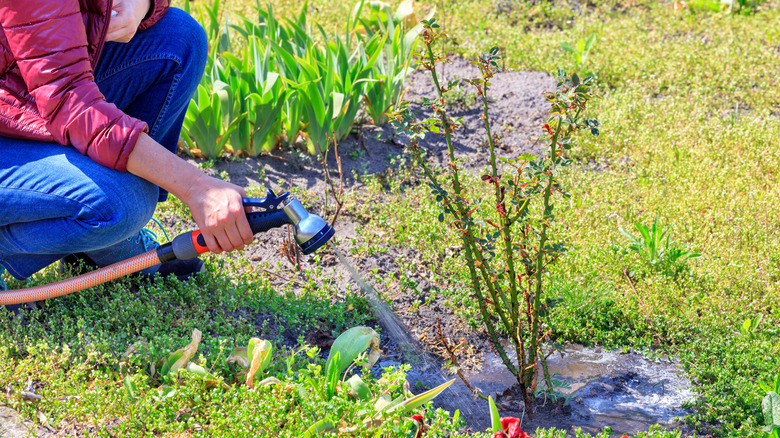How To Spot The Sneaky Signs Your Roses Are Overwatered
With so many different rose varieties that will make your garden smell heavenly, who wouldn't want to plant one in their backyard? With proper care, these beautifully scented flowers can live between 10 and 50 years, so you can reap their rewards for a long time. However, overwatering roses can significantly decrease their lifespan. Unfortunately, the signs of overwatering are often too subtle to notice until it's already too late. That said, if you know exactly what to look for, you can spot signs of overwatering early and intervene to save your precious flowers. So the next time you're out watering the roses, keep your eyes peeled for telltale overwatering signs such as yellowing leaves, wilting, mushy stems, mold, and edema.
After putting in the work to grow beautiful roses, the last thing anyone wants is to kill the plant with too much moisture. But even if you plant them in the best location with the right light conditions and follow expert tips for perfecting your soil, overwatering can still cause utter chaos. Before you go fill your watering can, it's time to get familiar with these sneaky signs.
How to tell overwatering from underwatering in roses
One of the most obvious signs of overwatering is yellowing leaves. You will likely notice these first at the bottom of your plant, where leaves will turn yellow, go limp, and eventually fall off. Another thing to look for near the base of your roses is mushy stems. Rose stems, often called canes, should have a nice green or greenish-red color and feel firm to the touch. When overwatering occurs, these stems become waterlogged and lose their firmness and color. Both yellow leaves and mushy stems can be a sign that root rot is occurring.
Wilting is another sign you may be overwatering the plant. What's tricky about this symptom in particular is that it can also be caused by underwatering. To tell the difference, check the petals and leaves with your finger — if they feel dry and brittle, underwatering is likely the cause, but if they feel soft or mushy, you've probably overwatered.
A less noticeable symptom to look for is edema. Edema is caused by excessive water retention and results in small blisters on the underside of your rose bush leaves. Other common signs include mold or mildew. Powdery mildew is quite common in roses and, as the name suggests, looks like a white powder on the leaves of the plant. Both powdery mildew and other types of molds and fungi, such as gray mold, thrive in wet, humid conditions, so even if overwatering is not the cause, it can still cause the mold to flourish and spread.
Tips for preventing overwatering
The best way to deal with these overwatering issues is to stop them before they even happen with a solid rose watering routine. Of course, different types of roses will require different watering schedules. For example, roses planted in pots dry out faster than those planted in the ground and will require more frequent watering.
Stephanie Waltz, a Rose Trial Coordinator at Star Roses and Plants, tells Southern Living that, "A good rule of thumb is to make sure that your roses are receiving 1 to 2 inches of water per week during the growing season. If you're not sure how much it's rained or if your roses need water, the soil moisture can offer insight." To figure it out, she recommends simply sticking your finger about an inch into the soil to feel if it's dry. Other helpful watering tips include watering directly at the base of your plant, watering in the morning rather than the evening, and adding a layer of mulch to help retain moisture.


